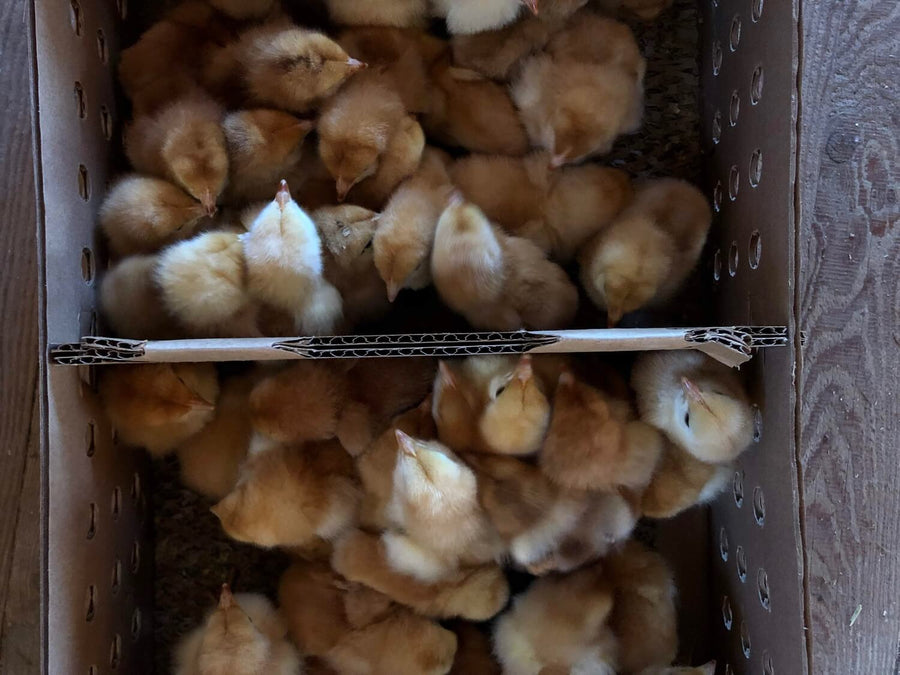
Essential Guide to Raising Chicks Safely
The first time we had baby chicks arrive at the farm, we were completely underprepared—and the same thing happened the second, third, and the fifth time. But now, having raised chicks several times a year for the past ten years, we have finally developed a routine that I urge first time chicken parents to follow. My biggest takeaway? A tried and true plan ensures the safety and health of the chicks.
How to build a chick brooder
Their new home, known as a brooder, should be ready for your chicks by the time they arrive. I’ve successfully raised chicks in just about every kind of container you could fathom, from old sinks to bathtubs to boxes by the woodstove—and even a shoebox. Essentially, chicks need heat, food, water, and shelter from the elements and predators. Ideally, this comes in something a bit more robust than a shoebox, but no matter where you decide to build your brooder, there are a few basic elements to check off your list before your chicks can make it their new home. Make sure that:
- The brooder is in a safe place
- The floor of the brooder is covered in wood shavings
- The heat source is on
- The food source is full
- The water source is full

Keeping your chicks safe
Like any young animal, chicks are extremely vulnerable to their surroundings, including predators, temperature, and inclement weather. When choosing where to build your brooder, safety should be top of mind.
Living predators
Everything is a potential predator for a day old chick. From your charming and overly zealous toddler (trust me, their enthusiastic hugs can be lethal to chicks—and I wish I didn’t know this from experience) to your friendly house cat or the rats taking shelter in your basement. Knowing the potential dangers in and around your home will help you decide whether a cardboard box in your mudroom or a fully enclosed setup in your garage or barn is the safest option for your hens. If you have issues with large rodents, raccoons, or owls, make sure your brooder has a latching door. If you have young children, it's best to place the brooder somewhere outside of the house, such as a garage, shed, or barn.
Environmental predators
Baby chicks are born into the world covered in fluff, not in feathers. Feathers are what keep a bird warm and dry, and without them, chicks can easily die from exposure to the elements. For this reason, your brooder should be sheltered from wind, rain, and cold drafts, especially for the first few weeks.
Laying down wood shavings and bedding
When raised with their mother hen, chicks spend much of their first days of life under her feathered body. They may poke their heads out occasionally (which is an adorable and comical sight), but will mostly stay snuggled underneath their mama for warmth. After a few days of hiding, they'll venture out and scurry about to eat and drink, but always return to mom for warmth and protection, especially at night when the temperatures drop. Their fluffy bodies aren’t nearly as insulating as feathers, so it's important to provide a substitute to the mama hen for your new, motherless chicks. This can be done by laying down shavings on the floor of your brooder. If you're building it inside, put newspaper or mats down first to save your floors and soak up any mess. Keep the shavings at least an inch thick on the floor of the brooder: this is not only for warmth and comfort, but also to keep mess to a minumum. Sprinkle fresh shavings on the heavily trafficked part of your brooder daily.
Adding a heat source
Without the warmth of their mother and fully developed feathers, chicks need a source of heat to keep them cozy and comfortable in their new home. There are a couple options to consider:
Heat lamps
In the past, the default heat source for at home brooders has always been a heat lamp. Heat lamps are relatively inexpensive, but their energy cost can be quite high, and if not secured properly, they can become a dangerous fire hazard. Most heat lamps will only last one season (two if you’re lucky). There are many different models on the market, some with added safety mechanisms to reduce the risk of fire. Some sit atop a relatively stable tripod, while others come with a cage fully surrounding the bulb. Then, there is the traditional variety that can be found at any feed store; an old faithful, at least until the barn burns down (needless to say, this type is not recommended). If you choose to purchase a heat lamp, be sure to get an infrared bulb. Unlike traditional white lightbulbs, the red light won't keep the chicks awake or disturb their sleeping pattens, allowing them to rest when they need to. The bulb should sit just high enough off the ground that the chicks are neither crowding under it (a sign that they're too cold) or flocking away from it (a sign that they're too hot).
Warming huts
Recently, there has been a new development in warming and heating equipment for brooders: the heating plate, also known as a warming hut. Warming huts are much safer and run at a lower wattage than heat lamps. They mimic the general shape and height of a mother hen, and in most models, you can even raise the legs as the chicks get bigger. Warming huts practically eliminate the potential for fires or overheating, which is well worth the higher price tag in my opinion. If cared for properly and cleaned after each use, the hut can last for years, successfully warming up multiple generations of chicks.

Food and water
With shelter and heat taken care of, the last additions to your brooder should be food and water. Baby chicks must have clean water that's refreshed daily available to them at all times. Chickens are not known for their swimming prowess, and chicks in particular are highly susceptible to drowning in the smallest of water bowls. To eliminate that possibility, choose a waterer that feeds into a drinking dish. Never give your chicks a bowl of water.
Baby chicks need a diet higher in protein than adult chickens do. To ensure that they're getting adequate nutrition to grow and thrive, feed them a mash designed expressly for baby chicks, which usually comes in the form of a finely ground and easily digestible feed labeled "chick starter mash." Some feed will inevitably go to waste if provided to the chicks in a bowl, so try one of those handy feeders that they can stick their little fluffy heads through for optimal feeding. I’m partial to the metal ones, which rarely break and can usually fit a Mason jar full of feed on top. Whenever possible, buy organic feed, which will keep harmful pesticides and GMOs out of the chain of food production, consumption, and waste management at your home.
Preparing for the arrival of your chicks
When you purchase chicks online from a hatchery, it's imperative to note their estimated arrival date. Chicks will typically be sent in a well ventilated cardboard box accompanied by a small cup of water and a few electrolyte packets. They are meant to be able to survive in such conditions for one or two days.

Delivery day
Make sure you are home and available for your chicks' arrival the day the hatchery (or your local hardware store) schedules delivery. Even if you receive your usual mail at home, note that chicks will always be delivered directly to your town’s post office; they will not be shipped to your door. Chicks arrive first thing in the morning, so you should expect a call from the postmaster around 7:00 AM. Be ready and available to go pick them up and head staight home. Don't plan additional errands, as these small creatures should be your priority for the morning. If you don’t hear from your local post office by mid-morning, give them a call. It's possible they are inundated with baby chicks (especially if it's springtime), and your number simply may have been lost in the shuffle.
Beyond the brooder
Depending on the size of your brooder, the chicks will remain inside anywhere from two to six weeks. Essentially, you want to make sure they still have all of the above while transitioning from fluff to feathers. Once “feathered out,” they can move to a chicken coop. Here, they won't need a heat source (except on very cold winter nights) and can grow, live, and lay as adult hens.
Ready to move your growing hens out of their brooder? Read on for Kate's guide to building your own chicken coop.

A note from Pete and Gerry's: For generations, our family of farmers at Pete and Gerry’s Organic Eggs has been dedicated to revolutionizing the way eggs are produced in the United States. We believe that consumers deserve better eggs from happier chickens living on small farms run by fairly paid farmers, and that’s what we have dedicated our business to. We also believe deeply in the transparency and verification of our standards, which is why we became a Certified B Corporation in 2013. It’s also why our farms meet the rigorous Certified Humane Free Range and USDA Certified Organic standards. We take the welfare of our hens, the sustainability of our farms, and health and happiness of our partner farmers and consumers very seriously. The resulting eggs are ones that stand out in the supermarket; they remind consumers of the eggs from their childhood farms and excursions abroad in Europe. And we're happy to be second best. In fact, we believe that everyone deserves a chance to raise hens right in their backyard and experience the joys that come with raising and growing food at home. Kate MacLean of Longest Acres Farm is here to tell you how.
Kate MacLean lives and works on 120 acres of land known as Longest Acres Farm in Chelsea, VT with her husband Nick, son Leland, and daughter Amelia. As an ex-city-dweller, she gained valuable experience working on friends' and neighbors' farms before making the move to rural Vermont with her family in search of a fulfilling, self-sustaining way of life.
Her breadth of experience in farming and raising countless varieties of chickens and other livestock on Longest Acres Farm not only makes Kate an expert in her field, but an advocate for home grown food and self-sustainability.












